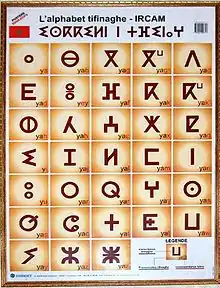Royal Institute of Amazigh Culture
The Royal Institute of Amazigh Culture (French: Institut royal de la culture amazighe (IRCAM); Standard Moroccan Tamazight: ⴰⵙⵉⵏⴰⴳ ⴰⴳⵍⴷⴰⵏ ⵏ ⵜⵓⵙⵙⵏⴰ ⵜⴰⵎⴰⵣⵉⵖⵜ, romanized: Asinag Ageldan n Tussna Tamazight (SGSM); Arabic: المعهد الملكي للثقافة الأمازيغية, romanized: al-Ma‘had al-Malikī lith-Thaqāfah al-Amāzīghīyah) is an academic institute of the Moroccan government in charge with the development and the promotion of the Berber languages and culture and of the development of Berber language courses for Morocco's public schools.
 Entrance to the Royal Institute of Amazigh Culture | |
| Latin: Royal Institute of Amazigh Culture Institut royal de la culture amazighe | |
| Established | 2001 |
|---|---|
| President | Ahmed Boukouss |
| Secretary General | M. E. H. El Moujahid |
| Address | Alal Fasi Street PO Box 2055 Hay Riad |
| Location | , |
| Website | www.ircam.ma |
The institute is located in the Moroccan capital of Rabat. It was officially founded on October 17, 2001 under a royal decree of King Mohammed VI (Dahir (royal decree) number 1-01-299). The institute has legal and financial independence from the executive branch of government, but its recommendations about the education of the Berber languages in Moroccan public schools are not legally binding to the government.
Role
The Institute offers advice to the Moroccan king and government about the measures that would help develop the Berber language and culture, especially within the educational system.
Responsibilities
- Maintain and develop the Berber language.
- Work on the implementation of policies adopted by the King on the subject.
- Help include the Berber language in the Moroccan educational system and ensure its presence in the social and cultural fields and in national, regional and local media.
- Reinforce the status of the Berber culture in the media and society.
- Work with other national institutions and organizations, especially with the ministry of education.
- Act as a reference in the domain of academic Berber studies and research, regionally and internationally, especially in North Africa.
Tifinagh

The institute has played a pioneering role in the adoption of Tifinagh for the transcription of Berber languages in Morocco.
The adopted transcription system is an alphabet, as opposed to the original Tifinagh maintained by the Tuaregs which is an abjad. It is made up of 33 characters and is largely inspired by the neo-Tifinagh developed in the 1970s by Kabyle militants.
See also
References and notes
Much of the content of this article comes from the equivalent Arabic-language Wikipedia article, accessed October 7, 2006.